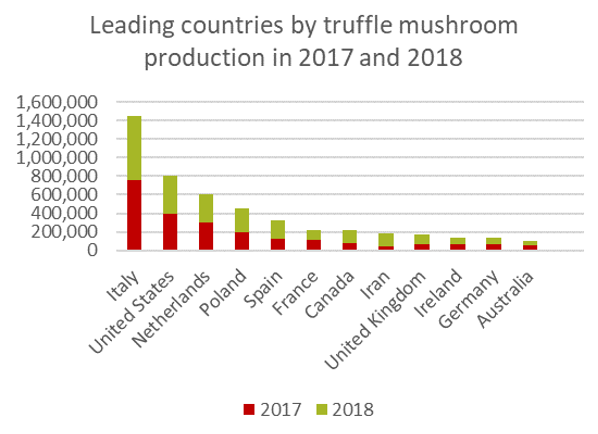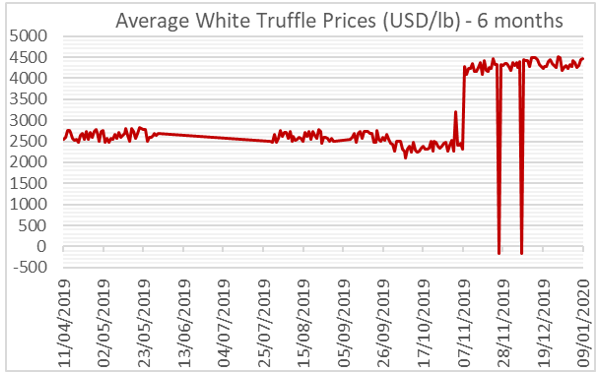Could climate change lead to the complete extinction of truffles? BSc Financial Economics with Accounting student Nada Hinic explains.
“All that is gold does not glitter,
Not all those who wander are lost;
The old that is strong does not wither,
Deep roots are not reached by the frost.”
(J.R.R. Tolkien, The Fellowship of the Ring)
Could climate change lead to the complete extinction of truffles? According to some scientists, it is quite possible: the increase of dry and hot weather in the regions of Italy, France and Spain can lead to a very serious situation for truffles, with the possibility of them disappearing completely in these regions by the end of the century. This would mean that the delicacy, which is already dizzyingly expensive and can be compared to the price of gold, would reach the value of an even more incredible level.
We can find strong evidence in historical articles on culinary culture that 18th and 19th century Europeans consumed truffles abundantly, from which it can be concluded that this fungus was not expensive. In the last 100 years, crops in the regions of Italy, France and Spain have decreased from a harvest of 2,000 tonnes a year to just about 20, due to global warming, acid rain, and, more recently, heat waves and reduced rainfall.
Scientist Ulf Buntgen, in his latest study ‘Black truffle winter production depends on Mediterranean summer rainfall’ (for which he used 49 years of continuous harvest and climate data from Spain, France and Italy) claims that truffle production rates from November to March significantly rely on previous rainfall from June to August, and that too much autumn rain adversely affects the later winter harvest.
The question might be asked how the market manages to survive. The logical answer would be that dealers have turned to alternative sources. Truffles themselves are not uncommon. Many sources in Europe still under the radar are producers in Croatia, Poland, Serbia, Albania … where they grow the same species as in the three most popular European regions. Why is that so? Truffles that are claimed to come from France or Italy (regardless of country of origin) achieve a premium price.
China has been, for several years now, the largest producer and exporter of truffles in the world. However, the quality of Chinese truffles is not satisfactory to any world standard, so their market price is very low. Australia and New Zealand are also on the horizon, but their production only covers their local demand. With the greatest sadness, one must also ask: will the Australian truffle market survive the devastation brought by the recent forest fires? The US has also entered the market recently, but it cannot be considered a serious competitor to the Europeans as yet.
All the sources combined are not enough to keep up with the demand for this delicacy. In 2019, a pound of quality black truffle cost about $650, and white almost $2000 (however the price soared again in November 2019). In 2017, due to too much drought in the previous year, the yield of white truffles was so weak that the price of one pound of white truffles skyrocketed to $4000.
London restaurateurs charge around £5 per gram of truffle shavings, claiming they make no profit on truffle, but the reason for the offer is the quality of the dish: ‘only few shavings can turn the dish from ordinary to extraordinary’.
Because of their hidden underground life cycle, truffles have aroused the interest of many scientists and many mysteries about them have now been revealed, though not all.
Truffles are hypogenous fungi: that is, unlike mushrooms on stems, they grow underground. Buried, their interaction with the rest of the living world is very complex. They depend on their hosts on which they feed, which are primarily oak and hazelnut trees and fir trees. The development of truffles is a wonderful harmony between the tree and the truffle itself: the tree provides the truffle with sugar and the fungus gives the tree nutrients from water and soil. Fertilisation depends on the animals they can feed with their trunks, not on the wind, to spread its spores. To attract the attention of animals, when truffles mature, they turn on their spectacular scent, sending signals to anyone available to them that they are ready to be excavated so they can be dispersed.
But if truffles are so rare and desirable, why not just grow your own? The answer is that truffle cultivation is harder than it looks, and many scientists have addressed the issue. In recent decades, techniques have been developed to vaccinate tree seedlings with truffle mycelium, but the process is still difficult and does not necessarily guarantee that truffles will mature. Italian white truffles do not respond to these techniques at all, while French black truffles, on the other hand, are more susceptible to domestication.

Source: Leading countries by mushroom and truffle production 2018 (source: https://www.atlasbig.com/en-us/countries-mushroom-truffle-production) Leading countries by mushroom and truffle production 2017 (source: https://www.worldatlas.com/articles/the-world-s-top-producers-of-mushroom-and-truffle.html)
The irrigation technique remains a safe method to preserve the survival, especially of the white truffle, as Buntgen observes in his work, but this also has its limitations. Recognising the vulnerability of the sector, there is a need to further foster stronger connections between farmers, politicians and scientists in order to maintain environmental and economic sustainability under the predicted climate change in southern Europe.
Further Information:


